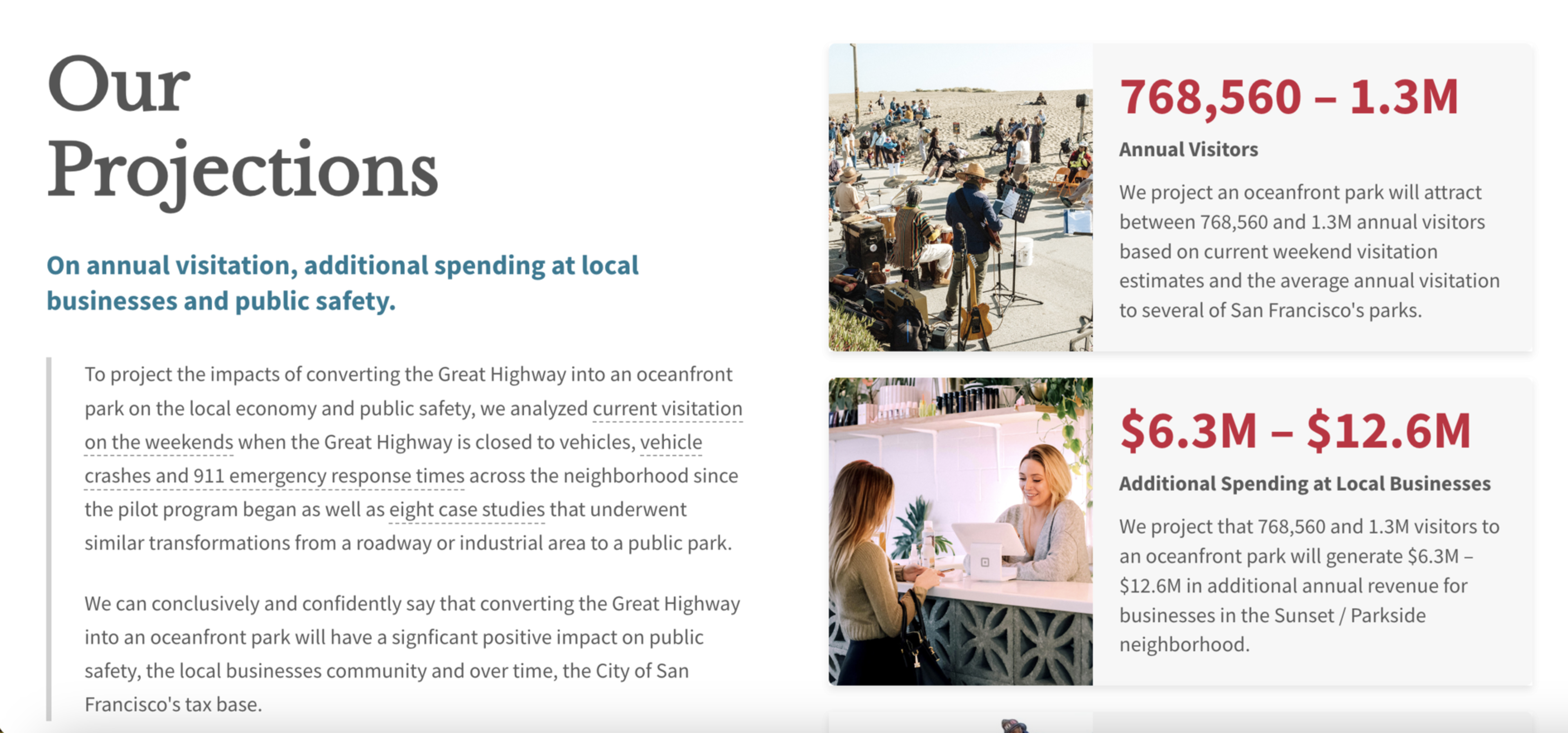Nearly 10,000 people head to the Great Highway every weekend — way out to the “Outer Lands” of the Sunset and Parkside neighborhoods, where sand regularly carpets the highway and car traffic is replaced by families on scooters, skateboards, and bikes.
Many of those people behave like my wife and me, who live car-free in the Haight. On weekends, I ride my bike to her art studio near the Great Highway and then we meet up with friends at the log bench at Noriega. On my way over, I’ll usually grab a coffee at Andytown or a boba tea at Quarters, or pick up a four-pack of beer from Woods. We listen to music, watch the sunset, and get dinner and drinks at Pizza Place on Noriega, Hook Fish, Outerlands, or Toyose. We typically spend anywhere from $40 to $80 during each visit.
This isn’t just anecdotal. It correlates with my extensive research (opens in new tab) examining city data and case studies from other municipalities where waterfront roadways and industrial areas have been converted to public parks. In all eight of the examples I analyzed, these conversions generated an economic windfall for local businesses.
Perhaps the best example is Hudson River Park (opens in new tab) in New York, a 4.5-mile waterfront area created when the city tore down the elevated West Side Highway in the late 1990s. Hudson River Park directly supports more than 3,000 jobs and has produced some $1.1 billion in economic benefits for New York City.
A similar scenario played out in the late 1970s, when city planners in Portland, Ore., tore down Harbor Drive to create Tom McCall Waterfront Park (opens in new tab). Today, it generates an additional $56 million in small-business revenue thanks to free events and festivals throughout the year.
Away from the coasts, the Indianapolis Cultural Trail (opens in new tab), which converted roadways, parking lots, and sidewalks to a network of bike and pedestrian paths, generates an additional $21 million a year for local businesses and has created more than 11,000 jobs since it opened in 2013.
The Sunset in San Francisco could share the same future if city residents vote in favor of Proposition K (opens in new tab) this November, converting a two-mile section of the Great Highway to a permanent public park. I estimate that such a conversation will attract up to 1.3 million visitors annually, generating as much as $13 million in additional spending (opens in new tab) for Sunset and Parkside businesses. Additionally, city data suggest that closing that section of the Great Highway to cars will likely reduce vehicle crashes and shorten emergency response times (opens in new tab) across the neighborhood, even as visits more than triple.
I am not naive to think that these estimates will change opponents’ minds about the viability of the park proposal. I understand why business owners may oppose a plan that will reroute traffic in their neighborhood. Small businesses across the city are still reeling from the Central Subway, Van Ness rapid bus lanes, Valencia Street bike lanes, and, most recently, “the nightmare on Taraval Street,” a five-year construction ordeal that pushed some owners to the brink.
Thankfully, the Great Highway is under the jurisdiction of the San Francisco Recreation and Parks Department, which has done an enviable job with the permanently car-free JFK Promenade in Golden Gate Park. Once a cut-through for car commuters, it now has 3 million visitors (opens in new tab) each year.

All the case studies I analyzed were controversial when they were proposed, just as tearing down the Embarcadero Freeway was fiercely fought over in the early 1990s. Yet today, it’s impossible to imagine returning any of these vibrant public spaces to their former states of urban blight.
In a few weeks, we’ll have an opportunity to open our oceanfront to all of San Francisco and introduce hundreds of thousands of pedestrians and cyclists, scooters and skateboarders, and, yes, even drivers to everything the Sunset and Parkside have to offer. But that can happen only if San Franciscans vote Yes on K.
Stephen Braitsch is a data analyst and founder of Transpo Maps (opens in new tab).